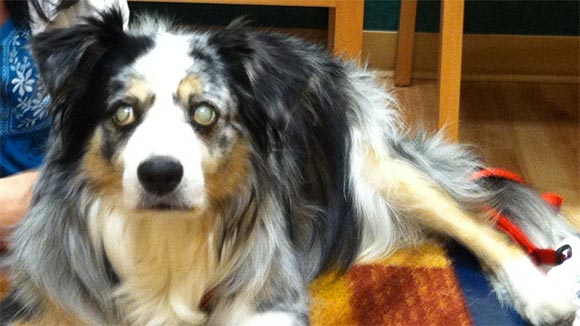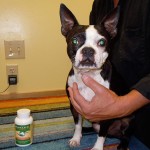
This 7 year old Yorkshire terrier has PRA (the typical age that these dogs are presented for ophthalmic examination). Note the widely dilated pupils. She was presented for examination because of gradually worsening night vision over the past several months, and was now starting to bump into things in daytime light. If you took a flash photo of her face, the “eye shine” would be VERY bright– much more than normal due to the dying retina causing hyperreflection from the eyeshine layer (“tapetum”) in the back of the eye.
Progressive Retinal Atrophy (PRA) is an inherited disease of the retina (the “film in the camera”) in dogs, in which the rod cells in the retina are programmed to die. PRA occurs in both eyes simultaneously and is nonpainful. There are many different types of inherited retinal degenerative diseases in purebred dogs, and discussing these are beyond the scope of this article. PRA occurs in most breeds of dogs and also occurs in mixed breeds. It is recessively inherited in all breeds studied, with the following exceptions: PRA is dominantly inherited in Old English Mastiffs and Bullmastiffs, and is sex-linked and found primarily in male dogs in Siberian Husky and Samoyed breeds.
Because PRA makes rods die, and rods are responsible for vision in dim light (“night vision”), the first clinical signs that the owner often notices are night-blindness (poor vision in dim light) and that the pupils are dilated; owners often notice a “glow” and increased “eye shine” from the eyes. Clinical signs in dogs with PRA vary from the dog first becoming night blind in the early stage of PRA, to the entire visual field in all light levels becoming affected in advanced PRA. In the final stage of PRA, the dog is completely blind. The natural course of the disease, if specific daily antioxidant supplementation is not given, is that all dogs with PRA will develop blindness within one year.
PRA is a blinding disease in most affected dogs, but in the opinion of many veterinary ophthalmologists, including Dr. McCalla, PRA is no longer a hopeless disease. New insight into the mechanisms of retinal damage from oxidative stress has resulted in much more hope for prolonging the vision of affected dogs. Typical PRA is a disease caused by a mutation in the rod photoreceptors (rods are responsible for night vision/ vision in dim light) leading to their death. Cones are responsible for daytime vision/ vision in bright light, and also for color vision (dogs do see color, but not as well as humans do). The dog retina has about 120 million rods and cones; of these, only 5% are cones (6 million). Thus, PRA kills 95% of the photoreceptors!
When the rods die, there is a lot of “left-over”, excessive oxygen delivered to the retina that the dead rods can’t use anymore. Cone death subsequently occurs due to excessive oxygen exposure in the face of rod death from damaging oxidative stress mechanisms. After the rods die, the excessive “left-over” oxygen is toxic, causing oxidative damage and ultimate death of cones. Specific antioxidant supplementation with Ocu-GLO™ helps protect cones and their function. Ocu-GLO™ is an antioxidant nutritional supplement designed specifically for canine vision health. Thus, OcuGLO™ helps save cones (vision in bright light)—if the dog is placed on supplementation soon enough.
While there is no cure and no medical treatment for PRA, supplementation with Ocu-GLO™ helps support the retinal health of affected dogs. Affected dogs diagnosed with PRA before complete vision loss may be helped by antioxidant nutritional support. After over three years of clinical research and development, Dr. McCalla and Dr. Carmen Colitz (a veterinary ophthalmologist) and Debra Smith RPh (a compounding pharmacist) developed Ocu-GLO™. Our clinical experience in our PRA patients with Ocu-GLO™ is very encouraging; some PRA-affected dogs have been on the supplement for over seven years, and these patients have not lost all of their vision.
Don’t give up! PRA is no longer a hopeless disease. Have your dog examined by a board-certified veterinary ophthalmologist to determine if PRA is indeed present. If you are located in the Pacific Northwest or in British Columbia, you may contact our office to schedule a comprehensive ophthalmic examination. For a list of board-certified veterinary ophthalmologists, please visit www.acvo.org . Dogs with PRA should not be bred, and the breeder that you received your dog from should be notified that the dog is affected so the breeder can alter their breeding program.
Dogs with PRA usually develop cataracts that are termed “toxic cataracts”, in the mid to late stages of PRA. Cataracts are opacities within the lens, and usually both eyes of dogs with PRA develop cataracts. There are many causes of toxic cataracts, but the most common cause in dogs is PRA. As the retinal tissue slowly dies, it releases toxic by-products of cell death that are absorbed by the lens, causing lens damage and cataract development. The cataracts can be severe enough to aggravate vision loss. In addition to supporting retinal health in dogs with PRA, antioxidant nutritional supplementation helps reduce the severity and slow the progression of toxic cataracts. If retinal function is completely lost in a dog with PRA but toxic cataracts are mild, antioxidant supplementation with Ocu-GLO™ might be continued in these patients to help support lens health in an attempt to delay cataract progression. This is because while vision cannot be restored, there can be painful complications from the development of advanced cataracts. Cataract surgery would not be performed in these patients, as it would not help restore any functional vision.

This dog has PRA and secondary toxic cataracts. Note the widely dilated pupils.
If the toxic cataracts interfere with vision but reasonable retinal function is still present, cataract surgery might be considered. Traditionally, cataract surgery has not been performed in dogs with PRA because the retinas die. It is the belief of Dr. McCalla, however, that a dog with PRA that is on daily Ocu-GLO™ antioxidant supplementation AND still has some viable retinal function at the time that the cataracts progress, can undergo cataract surgery. It is also important to know that advanced cataracts can cause not only increased vision loss but also inflammation, pain, and further damage to the eye. Therefore, if cloudiness and/or pain develops in the eye(s) of dogs with PRA, re-examination by a veterinary ophthalmologist is recommended ASAP. Secondary painful complications that might occur include glaucoma and lens lunation.
It is VERY important that dogs with PRA are given the recommended dose of Ocu-GLO™ every day; in our experience, PRA is a disease that does not forgive underdosing. Dogs with PRA that are underdosed on antioxidants still lose their sight gradually. AND—do not even consider using a human supplement (such as OcuVite) instead of Ocu-GLO™! OcuVite is not suitable for support of retinal function in dogs, and these dogs, in our experience, will go blind.

Dog with PRA; note the dilated, “glowing” pupils. This dog developed secondary toxic cataracts, was supplemented daily with Ocu-GLO, and underwent successful cataract surgery.
It is important to understand that most dogs with PRA are happy dogs with an acceptable quality of life. The retinal damage is not painful, and dogs usually adjust very well to their slow loss of vision. In fact, if a dog were destined to lose vision and Dr. McCalla could pick the disease, it would be PRA; vision loss is slow and nonpainful, and the dog is given much time to adjust to progressive blindness. As mentioned earlier, however, PRA is not necessarily a hopeless disease as far as continued vision loss is concerned; affected dogs that still have some vision may benefit from specific antioxidant supplementation to support retinal and lens health.
It is also important to realize that it is OK to grieve about your pet’s vision loss, but you must not put your sad feelings in your dog’s head—they aren’t really there! Your dog is not suffering. They adjust well to their vision loss, and it is by far hardest to deal with on the owner’s side. Your dog’s job description has not changed. Your blind dog is happy as long as its routine is stable. From your dog’s point of view, life continues to be great– you are there as always, and they just need to use their other keen senses a bit more to get the same information they used to view. Keep household furniture in its place, and consider purchasing the book “ My Dog is Blind but Lives Life to the Full ” by Nicole Horsky.
There are DNA blood tests available, to determine if dogs are likely affected with PRA, are likely carriers for PRA, or are not likely carrying the PRA gene. These tests are usually performed on purebred showdogs and breeding animals. Please visit this web site for further information: www.Optigen.com . If your dog is DNA-tested and found to be affected with PRA (but still has functional vision), it might benefit from oral antioxidant nutritional supplementation to support retinal and lens health. Additionally, if your purebred dog has been diagnosed with PRA by a veterinary ophthalmologist, the dog might be eligible for free DNA testing by Optigen as part of their ongoing research program. Any purebred dog that has been examined by a board-certified veterinary ophthalmologist (ACVO, ECVO) and that has been definitively diagnosed with PRA is eligible for review for possible inclusion in the Free Testing Program. Visit www.Optigen.com for more information.